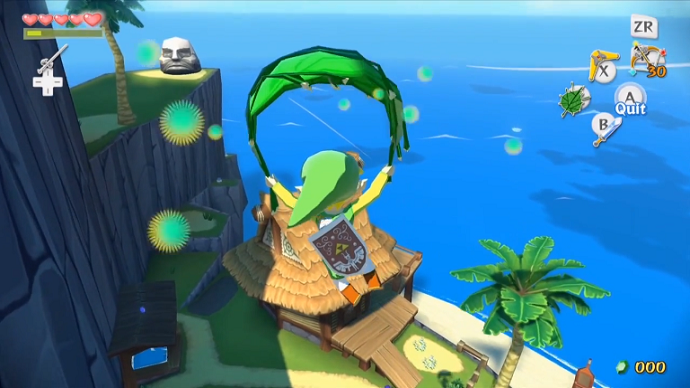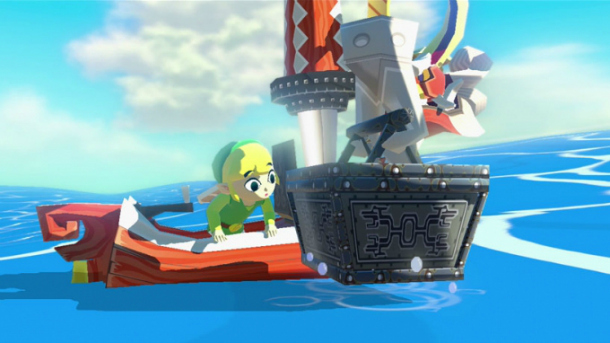Developer: Nintendo EAD3 / HexalDrive / DigitalScape
Publisher: Nintendo
Genre: Action-Adventure
Platform: Wii U
Released: 04/10/2013
Editions: Digital, Standard Retail, Collector’s Retail, Wii U Deluxe Set
When The Legend of Zelda: The Wind Waker was first unveiled in 2001, it’s cel-shaded art style became a point of controversy that blew the Marmite cliché out of the water. “It’s like a cartoon!” Ocarina fans bemoaned, while others compared it to a piece of art. Over ten years on and we now have in our hands an HD remake of the critically acclaimed title.
The HD remake has become a popular format with developers around the world, and is normally criticised for milking gamers of their hard earned cash on a game they bought ten years ago. This could have easily happened with The Wind Waker: upscale everything, slap HD on the box and off it goes.
But this is Nintendo we’re talking about here, who have already proved that they are willing to modify older games to make them better, like Ocarina of Time; and The Wind Waker HD gets some neat little upgrades that make it not quite the same game as the first time around.
The HD transfer itself looks incredible, especially when you consider that using a cel-shaded style ages games slower than using a realistic style. The new intense bloom lighting makes the characters look more plastic-y, but transforms the world around you into a livelier and brighter place. The grass feels sharper, the sea a bright blue with sharp-edged waves. It’s a world that’s so much more believable and immersive.
This applies to the music too. Many pieces in the game have been resampled, adding instruments that sound more realistic than their Gamecube counterparts. You mainly notice it in certain places, such as Windfall Island, Dragon Roost Island, and in one of the later boss battles. While the music sadly hasn’t been orchestrated, it still remains one of the best soundtracks in a Zelda game with its Celtic influence and memorable themes.
The Wii U doesn’t add just fancy graphics though, as the Gamepad brings the touchscreen map and inventory features from the 3DS and DS titles. Inside a dungeon the map screen will display the full dungeon map, while on the high seas provides the island grid, a compass, and dedicates a corner to treasure charts. These charts can be found by completing certain tasks and display the locations of treasure under the sea with a classic ‘x marks the spot’. The trick to finding the treasure is to tap an island square to zoom in, and then track the progress of your position on both the treasure chart and the island map. Activate your grappling hook when you are over the cross, and the treasure is yours! You don’t even have to look at the main TV screen, which takes a lot of the annoyance out of missing the shining orbs on the surface of the water. Sadly, being able to write on the map as in the DS titles still hasn’t returned, which means keeping track of collected items and pieces of heart is still difficult and time consuming. You shouldn’t have to traverse every part of the map to find the final piece of heart, especially when you can unlock a map that shows you all of the locations. It would have been rather simple for the game to keep track of what you had collected.
Item switching can now be done on-the-fly by simply dragging from your inventory to the X, Y or R slots, giving you an advantage in tight spots against bosses or large groups of enemies. The Wind Waker, which used to be an assignable item, is now tied to the up direction on the D-pad. When in use, the Gamepad displays the notes for all of the songs, which dismisses the difficulty in the original of either remembering all of the songs, or viewing them on the pause screen when you wanted to play one. During sailing, the left and right directions on the D-pad are assigned to the canon and grappling hook, saving you from constantly reassigning your items. On land however, the D-pad sees no other use than the Wind Waker and could have been put to use in giving you easier access to certain items such as your Pictobox (the in-game camera), especially with the emphasis on Miiverse integration.
The Miiverse integration replaces the GameBoy Advance functionality, with Tingle now giving you the Tingle Bottle instead of the Tingle Tuner. It’s a fun little add-on, allowing you to share your photos taken with the Pictobox. Being a community-driven feature, its quality depends on what people are posting, but you can get a laugh out of some people’s screenshots. You’ll find Tingle bottles floating on the surface of the sea, and picking them up displays a Miiverse post on the Bottle tab of the Gamepad. While it ties the Miiverse features closer in with the game it can be occasionally distracting, but you can turn this feature off. If you think you’re going to be posting a lot, the Pictobox has had an upgrade in that it now allows you to store up to twelve photos, and has the ability to take photos of Link himself. Colour photos are added a lot faster too, becoming available immediately after you complete the photography sidequest on Windfall Island, rather than having to additionally collect a firefly from Forest Haven like in the original.
This is just one of the few gameplay tweaks that Nintendo have implemented to make the game more playable, including the swift sail and the slightly shortened Triforce quest. The swift sail tries to tackle the issue of the long, empty seas in between islands, allowing you to travel much faster and change the wind direction automatically rather than having to rely on your Wind Waker. Although it does work in reducing the amount of time spent travelling, it still doesn’t change the fact that the overworld is empty, a problem that has continued to plague the console entries in the series. While the game was the result of an art style experiment and knocked up in less than a year, it would have benefitted the release to have had more development time to send out a ‘Master Quest’ equivalent. The relatively empty map squares used for some sidequests, such as the Flight Control Platform and the Boating Course, could have been replaced by new islands, perhaps adding extra dungeons, characters and sidequests, offering a fresh take on the original.
This would have also solved the problem with the quest to obtain the eight pieces of the Triforce of Courage, which still feels like a section which drags the game out before its end. The original sent you out gathering treasure charts, all eight of which had to be deciphered by Tingle, costing you thousands upon thousands of rupees. The shortened version of the quest was supposed to cut down the amount of time you spent on this section and the amount of money you had to spend. Instead, it seems too much like patchwork. Some of the Triforce shards are now found directly in the chest instead of their treasure charts, which cuts down the time to acquire all of the shards. However, this just skips small sections of the game, rather than changing how it plays. While some would praise Nintendo for trying to keep as close to the original as possible, it solves nothing for those who wanted the Triforce quest radically transformed. This is where a ‘Master Quest’ edition of the game would have benefitted the flow of the story; perhaps three shards would have been enough: one under the sea, one in the Ghost Ship and one in a dungeon. At least they made an attempt at fixing the problems with the game’s flow, but their efforts simply weren’t enough.
Don’t let these issues put you off though, for The Legend of Zelda: The Wind Waker HD is still one of the finest Zelda titles in terms of its story and presentation. While its gameplay may be dated and lacks significant challenge, it still exudes immeasurable charm and offers hours of fun. The updated look and Wii U features make this the definitive version of the game and one that is worth the purchase, especially for those who missed it first time round.
8/10 – Very Good
